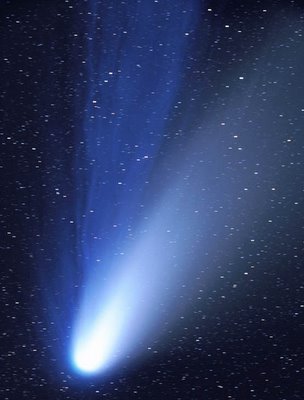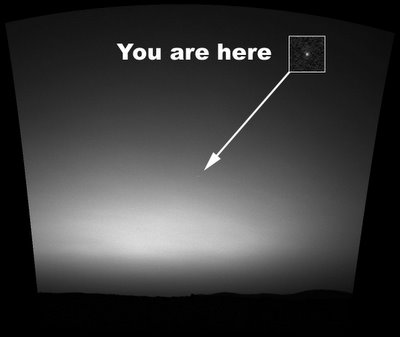 Last weekend, I gave two presentations to some Muslim children who attended a three-day camp run by my ustaz (religious teacher) over the Christmas holidays. The ustaz had mentioned in our classes that one of the other students would be bringing in his telescope for the children to look at the stars and planets, insha'allah. He did, in fact, bring his telescope in, but, as I feared, the sky clouded over very quickly after sunset, and it was virtually impossible to see anything in the sky all evening long. Unfortunately, this type of situation happens all too often here in S'pore. (I am rather spoiled, having lived beneath the clear desert skies of Phoenix for so long.) Because I did fear a cloudy sky might happen, I burned some CD-ROMs of various pictures about astronomy and space exploration to be shown at the camp. I had told the ustaz about the CD-ROM the night before, and so there was a laptop computer and projector ready to go at the camp. (Last night, while attending class, the ustaz and several others thanked me for having brought in the CD-ROM as it had saved the evening.)
Last weekend, I gave two presentations to some Muslim children who attended a three-day camp run by my ustaz (religious teacher) over the Christmas holidays. The ustaz had mentioned in our classes that one of the other students would be bringing in his telescope for the children to look at the stars and planets, insha'allah. He did, in fact, bring his telescope in, but, as I feared, the sky clouded over very quickly after sunset, and it was virtually impossible to see anything in the sky all evening long. Unfortunately, this type of situation happens all too often here in S'pore. (I am rather spoiled, having lived beneath the clear desert skies of Phoenix for so long.) Because I did fear a cloudy sky might happen, I burned some CD-ROMs of various pictures about astronomy and space exploration to be shown at the camp. I had told the ustaz about the CD-ROM the night before, and so there was a laptop computer and projector ready to go at the camp. (Last night, while attending class, the ustaz and several others thanked me for having brought in the CD-ROM as it had saved the evening.)Making the presentations was a rather nice experience for me. One reason is because I've long had an interest in astronomy. My dad bought me a refracting telescope in 1973 as Comet Kohoutek went by the Earth, and I've been hooked ever since. (I was even an Astronomy major when I attended the University of Arizona in my idealistic youth. ;) Unfortunately, higher math ended my dream of becoming a professional astronomer, but I do continue to follow what's going on in astronomy and the other sciences.)
 Another reason for my satisfaction was being able to see people comprehend new ideas for the first time (actually, this happened more often with the adults than the kids, making it all the more gratifying). For example, in a discussion afterwards with some young men, they had never considered the idea that the light we see in the sky (whether it is starlight at night or sunlight during the day) is really showing us past events. As one brother said, he thought that what we saw in the sky was happening right now, instead of realizing that what we see in the night sky has come to us from hundreds, thousands, millions, even billions of years ago.
Another reason for my satisfaction was being able to see people comprehend new ideas for the first time (actually, this happened more often with the adults than the kids, making it all the more gratifying). For example, in a discussion afterwards with some young men, they had never considered the idea that the light we see in the sky (whether it is starlight at night or sunlight during the day) is really showing us past events. As one brother said, he thought that what we saw in the sky was happening right now, instead of realizing that what we see in the night sky has come to us from hundreds, thousands, millions, even billions of years ago."When you look into a night sky you see the stars far away, you're seeing them because of the light which travels from them to you. Now it takes time for light to travel here, so what you are doing is seeing the stars as they were in the past, the amount of time it has taken for the light to reach us and the further and further away those stars are, the further back in time you are looking. Now you are seeing a star that is say six thousand years ago, imagine somebody on that star looking at us, they would be seeing us as we were six thousand years ago. Which of those two is now? So space and time are linked together. As we are looking across space, we are looking back in time."
-- Professor Frank Close, "Temporalia," The Time Machine by Alan Parsons
I also enjoyed the fact that I could tie in several Qur'anic concepts to the pictures I was showing. With the picture of Venus (see above), I related how the planet is very similar to Earth (in terms of its size, mass, density, composition, and so on). However, Venus is also incredibly hot (over 467° Celcius/872° Farenheit) so that nothing can live there that we know of (lead would melt on the surface). We know that the dense Venusian atmosphere causes a runaway greenhouse effect, which is why there is such intense heat on the planet. Our concern as Muslims is that, because we are Viceregents for Allah (swt) here on Earth (2:30), we have accepted a trust (33:72) to care for the Earth and all its inhabitants, plant and animal. However, we have allowed too many greenhouse gases to escape into the atmosphere, causing problems like the hole in the ozone layer over Antarctica (ozone protects animal life - including humans - from damaging ultraviolet radiation). [For a graph that shows the size of the ozone hole in relation to the area of Antarctica and North America, click here. For links to various movies and graphs of satellite data showing ozone levels over Antarctica and the Northern Hemisphere, click here.]
The other Qur'anic concept I tried to point out is man's relationship to the universe and Allah (swt). For this, I used the below slide, showing the Earth as seen from Mars. In this photo, taken by Spirit, the Earth is merely a speck of light in the sky. Humanity has an unwarranted arrogance about itself, as the Qur'an points out numerous times. For example, "Nay, but man doth transgress all bounds, In that he looketh upon himself as self-sufficient." (96:6-7) and "Truly man is, to his Lord, ungrateful; And to that (fact) he bears witness (by his deeds);" (100:6-7) We view ourselves as being Masters of the Universe, and while we, humanity, have done many great things, we still inhabit an extremely tiny portion of the universe. We need to be reminded of our true place in the universe and who is truly the greatest, to whom we bow in Islam.

[Note: All of the above photographs were used in my presentation at the camp, and almost all were obtained from Astronomy Picture of the Day, a website that I highly recommend to anyone who has any interest in astronomy.]




